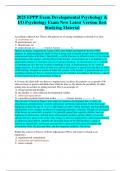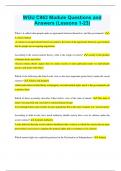2025 EPPP Exam Developmental Psychology &
I/O Psychology Exam New Latest Version Best
Studying Material
According to Speech Act Theory, the general act of saying something is referred to as a/an:
A. locutionary act
B. perlocutionary act
C. illocutionary act
D. propositional act ----------- Correct Answer ----------- A.
Speech-act theory, originated by Austin (1962) then further developed by Searle (1969),
proposes by understanding the detail of what is being said or uttered, people will understand and
communicate better with others. Specifically, a verbal utterance is defined in terms of its content,
the intention of the speaker, and the effect on the listener. A locutionary act is an utterance of a
meaningful sentence or statement, the act of saying something. An illocutionary act (c.) intends
to communicate. It is the way in which something is said. A perlocutionary act (b.) seeks to
change behavior. It is the effect of what was said on the listener or speech acts that have an effect
on the feelings, thoughts or actions of either the speaker or the listener. A propositional act (d.) is
something referenced, but no communication may be intended. According to the theory, a speech
act necessarily involves a locutionary act but m
A 16-year-old client tells you that on a regular basis, he drives his parents' car at speeds of 90
miles per hour or greater and drinks beer while he does so. He denies the possibility of either
getting into an accident or getting arrested. This is an example of:
A. formal operational thought.
B. the identity vs. role confusion developmental conflict.
C. adolescent egocentrism.
D. a possible psychotic break from reality. ----------- Correct Answer ----------- C.
This question is based on Piaget's four stages of cognitive development that, in order, are
sensorimotor, preoperational, concrete operational, and formal operational. In the final stage,
beginning at about the age of 11 or 12, individuals are able to think abstractly and hypothetically
and therefore solve complex problems by imagining alternative solutions. Though not all aspects
of the theory are universally accepted, it is generally agreed that cognitive abilities increase
beginning in adolescence, and that these advancements include a greater ability to focus on
oneself and one's place in the world. This change is often accompanied by a phenomenon known
as adolescent egocentrism, whereby the increased focus on the self introduces cognitive
distortions. Specifically, adolescent egocentrism is characterized by three distortions: the
invincibility fable, the personal fable, and the imaginary audience. The invinc
Within the context of Theory of Work Adjustment (TWA), job tenure is related to an
employee's:
A. organizational commitment.
B. satisfaction and satisfactoriness.
C. career concept.
, D. motivation and ability. ----------- Correct Answer ------------- B.
Dawis and Lofquist's (1964) model of career development, Theory of Work Adjustment (TWA),
centers on the connection between a worker and his/her job and work environment. A key
element of the theory is that an individual is best suited for positions that have matching
demands and rewards to his/her individual characteristics. According to the TWA, satisfaction
and satisfactoriness are factors related to job tenure. Satisfaction, in this theory, refers to a
worker's satisfaction with the job. This is established by the degree to which the worker's needs
are satisfied by the provided rewards of the job. Satisfactoriness, on the other hand, refers to the
organization or employer's satisfaction with the worker. For example, how well the worker's
skills fulfill the requirements of the job and is able to perform the job
In the auto service department at a car dealership, managers talk to customers, diagnose
problems with the cars, and assign repair tasks to mechanics. A new manager takes over so that
mechanics interact directly with customers and decide on their own what work needs to be done.
The new manager is using which of the following motivational techniques?
A. job enrichment.
B. job enlargement.
C. quality circle.
D. assessment center. ----------- Correct Answer ------------- A.
Job enrichment is a motivational technique that involves giving employees increased
responsibility, decision-making authority, and autonomy. Job enrichment is designed to reduce
boredom, and increase workers' feelings of meaningfulness, responsibility, and competence. It is
based on Herzberg's two-factor theory of motivation, which classifies factors that affect job
satisfaction into two categories: motivators, which increase satisfaction, and hygiene factors,
which prevent dissatisfaction. Motivators are related to intrinsic conditions of the job itself, such
as the autonomy and the opportunity for personal growth. In the question, the manager is
increasing the responsibility and autonomy of the mechanics, so job enrichment is the best
answer.
A 4-year-old girl cries when her teddy bear falls down the stairs. This is an example of:
A. animism
B. egocentrism
C. magical thinking
D. childhood schizophrenia ----------- Correct Answer ----------- A.
Animism is the belief that inanimate objects have thoughts, feelings, and other lifelike qualities.
Egocentrism (B) refers to thinking, observing, and judging things in relation to the self. Magical
thinking (C), which is based on egocentrism, is the erroneous belief that one has control over
objects or events. All of the above traits are normal in a preoperational child and do not indicate
Schizophrenia (D)
In regards to learning, children generally have an advantage over adults due to their greater:
A. brain plasticity
B. explicit memory
C. implicit memory
D. metamemory ----------- Correct Answer ----------- A.
Brain plasticity refers to the ability of the nervous system to adapt to different circumstances and
,to find new ways of learning. Plasticity is particularly useful for acquiring a new skill or
recovering from a brain injury. Children, as you might expect, have greater plasticity than adults,
although adults maintain some degree of plasticity throughout their lives. The greater plasticity
in children is attributed to their brains not being fully developed. The human brain continues its
development throughout childhood and into early adulthood, with significant increases in neural
connections and myelination. However, adults, having more life experience, have more explicit
and implicit memories. Adults also tend to have better metamemory, that is, greater knowledge
of what one knows and how one's memory works, although this ability may decline among older
adults
Adapting attitudes and behaviors to fit the expectations of what girls or boys are "supposed to
do" within a sociocultural environment is reflective of which gender-role identity development
theory?
A. Kagan's social learning theory
B. Bem's gender schema theory
C. Kohlberg's cognitive-developmental theory
D. Freud's psychodynamic theory ----------- Correct Answer ----------- B.
Bem's gender schema theory states children develop schema about what is expected of them as
girls or boys and then apply those schemas to their own behavior. Because it emphasizes both
social, notably sociocultural factors, and cognitive processes, it is classified as a social-cognitive
approach. Kagan's social learning theory (a.) focuses on social factors role on the development of
gender-role identity, yet focuses primarily on the impact of modeling and reinforcement.
Kohlberg's cognitive-developmental theory (c.) emphasizes the cognitive processes that underlie
gender-role identity development. Resolution of the psychosexual crisis of the phallic stage of
development is the emphasis of Freud's theory of gender-role identity (d.).
Non-consensual childhood sexual abuse generally has a:
A. more negative impact for females than males
B. more negative impact for males than females
C. similar impact for males and females
D. similar impact for males and females but a very different pattern of symptoms -----------
Correct Answer ----------- C.
This is a difficult question because the research results on childhood sexual abuse are
inconsistent. Many studies have found no consistent gender differences in impact or pattern of
symptoms, while other studies have found a more negative impact for females than for males.
One of the complicating factors has been the definition of childhood sexual abuse - which
includes consensual sex involving a minor when there is a significant age difference between the
two parties. However, when only non-consensual types of childhood sexual abuse are examined,
males and females are equivalently affected
The best strategy to stimulate an infant's learning and cognitive development would be to:
A. supply the infant with a daily problem solving task.
B. enroll the infant in preschool.
C. expose the infant as early in infancy to the written word.
D. ensure that the infant's physical and emotional needs are met. ----------- Correct Answer ------
----- D.
, Infants' learning and cognitive development is promoted primarily through their own exploration
of the environment around them. Meeting their physical needs helps ensure that they have the
physical ability to explore the environment, and meeting their emotional needs helps ensure they
have the security and confidence to do so. For this reason, the fourth choice is the best answer.
Regarding choice one, problem solving tasks certainly will help an infant develop cognitively,
but the wording of this choice makes it a weak answer. The infant should not have to be
"supplied" with a problem-solving task as each new stimulus she encounters in the environment
basically functions as one. Moreover, the choice suggests that the infant would be presented with
one task per day, but infants who have the opportunity, strength, and confidence to explore their
environment are presented with much more than a "daily" opportunity to
Kohlberg's theory of moral development focuses on moral reasoning. With regard to the linkage
between moral reasoning and moral action, Kohlberg would most likely agree with which of the
following?
A. There is a direct, one-to-one link between moral reasoning and behavior.
B. The link between moral reasoning and behavior is mediated by the individual's previous
experience with the situation.
C. The link between moral reasoning and behavior is mediated by the individual's IQ.
D. There isn't a one-to-one correspondence between moral reasoning and behavior, although,
the higher the stage of moral reasoning, the stronger the link is likely to be. ----------- Correct
Answer ----------- D.
Kohlberg believed there is a link between moral reasoning and moral action but felt that the
correspondence was greatest at the higher stages of moral reasoning.
An 11-month-old infant is presented with a new toy and hesitates to approach it, but then starts to
play with it after seeing his mother smile and hearing her verbally encourage him. This is an
example of:
A. social referencing.
B. secure attachment.
C. imitation.
D. emotional contagion. ----------- Correct Answer ----------- A.
Social referencing refers to using the emotional response of others as a cue as to how to respond
oneself. Infants begin to display social referencing at the age of about 6 months, when they are
influenced by the mother's mere presence; by about the age of 10 months, they begin to reference
their mother's faces. Social referencing in infants generally occurs in ambiguous situations, when
they are presented with novel stimuli or unfamiliar situations. A number of studies have
suggested that social referencing in infants reflects cognitive awareness of the meaning of
emotional expressions, and, contrary to choices 3 and 4, not simply imitation or contagion
The "terminal drop" phenomenon refers to:
A. declines in intellectual functioning
B. declines in sensory functioning
C. declines in REM sleep
D. declines in non-REM sleep ----------- Correct Answer ----------- A.
"Terminal drop" refers to findings indicating in the months before death, a substantial drop in all
facets of intelligence occurs.





